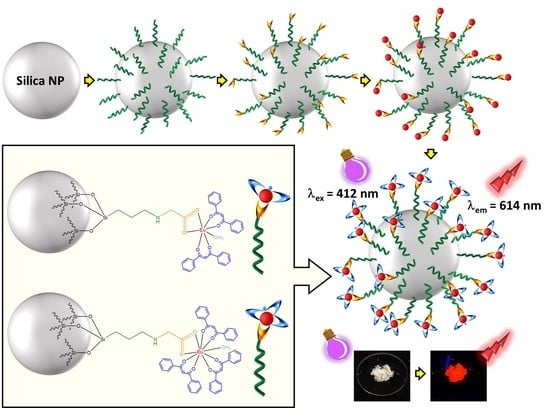Red-Emitting Hybrid Based on Eu3+-dbm Complex Anchored on Silica Nanoparticles Surface by Carboxylic Acid for Biomarker Application
Abstract
1. Introduction
2. Materials and Methods
2.1. Materials
2.2. Synthesis of Silica Nanoparticles
2.3. Amino-Functionalization
2.4. Carboxyl-Functionalization
2.5. Coordination of Eu3+ to -COO− Groups
2.6. Displacement of Coordination Water Molecules by dbm− Ligands
2.7. Instrumentation
3. Results and Discussion
3.1. Structure and Morphology
3.2. Luminescence
4. Conclusions
Supplementary Materials
Author Contributions
Funding
Acknowledgments
Conflicts of Interest
References
- Sábio, R.M.; Santagneli, S.H.; Gressier, M.; Caiut, J.M.A.; Pazin, W.M.; Leite, I.S.; Inada, N.M.; Da Silva, R.R.; Ribeiro, S.J.L.; Menu, M.J. Luminescent nanohybrids based on silica and silylated Ru(II)-Yb(III) heterobinuclear complex: New tools for biological media analysis. Nanotechnology 2020, 31, 085709. [Google Scholar] [CrossRef] [PubMed]
- Monteiro, J.H.S.K. Recent advances in luminescence imaging of biological systems using lanthanide (III) luminescent complexes. Molecules 2020, 25, 2089. [Google Scholar] [CrossRef] [PubMed]
- Ranjan, S.; Jayakumar, M.K.G.; Zhang, Y. Luminescent lanthanide nanomaterials: An emerging tool for theranostic applications. Nanomedicine 2015, 10, 1477–1491. [Google Scholar] [CrossRef] [PubMed]
- Chinnathambi, S.; Shirahata, N. Recent advances on fluorescent biomarkers of near-infrared quantum dots for in vitro and in vivo imaging. Sci. Technol. Adv. Mater. 2019, 20, 337–355. [Google Scholar] [CrossRef]
- Reddy, M.L.P.; Divya, V.; Pavithran, R. Visible-light sensitized luminescent europium (III)-β-diketonate complexes: Bioprobes for cellular imaging. Dalton Trans. 2013, 42, 15249–15262. [Google Scholar] [CrossRef]
- Chen, Y. Fluorescent probes for detection and bioimaging of leucine aminopeptidase. Mater. Today Chem. 2020, 15, 100216. [Google Scholar] [CrossRef]
- Pandey, S.; Bodas, D. High-quality quantum dots for multiplexed bioimaging: A critical review. Adv. Colloid Interface Sci. 2020, 278, 102137. [Google Scholar] [CrossRef]
- Bai, Y.; Shu, T.; Su, L.; Zhang, X. Fluorescent gold nanoclusters for biosensor and bioimaging application. Crystals 2020, 10, 357. [Google Scholar] [CrossRef]
- Li, H.; Yan, X.; Kong, D.; Jin, R.; Sun, C.; Du, D.; Lin, Y.; Lu, G. Recent advances in carbon dots for bioimaging applications. Nanoscale Horiz. 2020, 5, 218–234. [Google Scholar] [CrossRef]
- Jaque, D.; Richard, C.; Viana, B.; Soga, K.; Liu, X.; Solé, J.G. Inorganic nanoparticles for optical bioimaging. Adv. Opt. Photon. 2016, 8, 1–103. [Google Scholar] [CrossRef]
- Zhao, Q.; Huang, C.; Li, F. Phosphorescent Heavy-Metal Complexes for Bioimaging. Chem. Soc. Rev. 2011, 40, 2508–2524. [Google Scholar] [CrossRef] [PubMed]
- Mutti, A.M.G.; Santos, J.A.O.; Cavalcante, D.G.S.M.; Gomes, A.S.; Job, A.E.; Teixeira, G.R.; Pires, A.M.; Lima, S.A.M. Design of a red-emitter hybrid material for bioimaging: Europium complexes grafted on silica particles. Mater. Today Chem. 2019, 14, 100204. [Google Scholar] [CrossRef]
- Bünzli, J.C.G. Lanthanide light for biology and medical diagnosis. J. Lumin. 2016, 170, 866–878. [Google Scholar] [CrossRef]
- Binnemans, K. Lanthanide-based luminescent hybrid materials. Chem. Rev. 2009, 109, 4283–4374. [Google Scholar] [CrossRef]
- Sun, J.; Song, B.; Ye, Z.; Yuan, J. Mitochondria targetable time-gated luminescence probe for singlet oxygen based on a β-diketonate-europium complex. Inorg. Chem. 2015, 54, 11660–11668. [Google Scholar] [CrossRef]
- Lima, P.P.; Sá Ferreira, R.A.; Freire, R.O.; Almeida Paz, F.A.; Fu, L.; Alves, S.; Carlos, L.D.; Malta, O.L. Spectroscopic study of a UV-photostable organic-inorganic hybrids incorporating an Eu3+ β-diketonate complex. Chem. Phys. Chem. 2006, 7, 735–746. [Google Scholar] [CrossRef]
- DeOliveira, E.; Neri, R.; Serra, O.A.; Prado, A.G.S. Antenna effect in highly luminescent Eu3+ anchored in hexagonal mesoporous silica. Chem. Mater. 2007, 11, 5437–5442. [Google Scholar] [CrossRef]
- Lechevallier, S.; Jorge, J.; Silveira, R.M.; Ratel-Ramond, N.; Neumeyer, D.; Menu, M.J.; Gressier, M.; Marçal, A.L.; Rocha, A.L.; Martines, M.A.U.; et al. Luminescence properties of mesoporous silica nanoparticles encapsulating different europium complexes: Application for biolabelling. J. Nanomater. 2013, 2013, 1–12. [Google Scholar] [CrossRef]
- Ma, J.; Yang, D.; Song, X.; Wang, Y. Luminescent materials of covalent grafting lanthanide complexes to the synthetic clays. J. Lumin. 2019, 126–132. [Google Scholar] [CrossRef]
- Kataoka, T.; Abe, S.; Tagaya, M. Surface-engineered design of efficient luminescent europium (III) Complex-based hydroxyapatite nanocrystals for rapid HeLa cancer cell imaging. ACS Appl. Mater. Interfaces 2019, 11, 8915–8927. [Google Scholar] [CrossRef]
- Comby, S.; Surender, E.M.; Kotova, O.; Truman, L.K.; Molloy, J.K.; Gunnlaugsson, T. Lanthanide-functionalized nanoparticles as MRI and luminescent probes for sensing and/or imaging applications. Inorg. Chem. 2014, 53, 1867–1879. [Google Scholar] [CrossRef] [PubMed]
- Costa, A.L.; Bispo, A.G., Jr.; Lima, S.A.M.; Pires, A.M. Multicolor-emittingluminescent Y2O3:RE3+@SiO2-[RE3+(β-diketone)3] core@shell hybrids featuring dual RE3+ activator centers. J. Alloys Compd. 2020, 843, 155811. [Google Scholar] [CrossRef]
- Li, L.; Wang, W.; Tang, J.; Wang, Y.; Liu, J.; Huang, L.; Wang, Y.; Guo, F.; Wang, J.; Shen, W.; et al. Classification, synthesis and application of luminescent silica nanoparticles: A review. Nanoscale Res. Lett. 2019, 14, 190. [Google Scholar] [CrossRef] [PubMed]
- De Oliveira, L.F.; Bouchmella, K.; Goncalves, K.A.; Bettini, J.; Kobarg, J.; Cardoso, M.B. functionalized silica nanoparticles as an alternative platform for targeted drug-delivery of water insoluble drugs. Langmuir 2016, 32, 3217–3225. [Google Scholar] [CrossRef] [PubMed]
- Azevedo, C.B.; Batista, T.M.; de Faria, E.H.; Rocha, L.A.; Ciuffi, K.J.; Nassar, E.J. Nanospherical silica as luminescent markers obtained by sol-gel. J. Fluoresc. 2015, 25, 433–440. [Google Scholar] [CrossRef]
- Maturi, F.E.; Sábio, R.M.; Silva, R.R.; Lahoud, M.G.; Meneguin, A.B.; Valente, G.T.; Caface, R.A.; Leite, I.; Inada, N.M.; Ribeiro, S.J.L. Luminescent mesoporous silica nanohybrid based on drug derivative terbium complex. Materials 2019, 16, 933. [Google Scholar] [CrossRef]
- Malba, C.; Sudhakaran, U.P.; Borsacchi, S.; Geppi, M.; Enrichi, F.; Natile, M.M.; Armelao, L.; Finotto, T.; Marin, R.; Riello, P.; et al. Structural and photophysical properties of rare-earth complexes encapsulated into surface modified mesoporous silica nanoparticles. Dalton Trans. 2014, 43, 16183–16196. [Google Scholar] [CrossRef]
- Fedorenko, S.; Gilmanova, D.; Mukhametshina, A.; Nizameev, I.; Kholin, K.; Akhmadeev, B.; Voloshina, A.; Sapunova, A.; Kuznetsova, S.; Daminova, A.; et al. Silica nanoparticles with dual visible–NIR luminescence affected by silica confinement of Tb (III) and Yb (III) complexes for cellular imaging application. J. Mater. Sci. 2019, 54, 9140–9154. [Google Scholar] [CrossRef]
- Lourenço, A.V.S.; Kodaira, C.A.; Ramos-Sanchez, E.M.; Felinto, M.C.F.C.; Goto, H.; Gidlund, M.; Malta, O.L.; Brito, H.F. Luminescent material based on the [Eu(TTA)3(H2O)2] complex incorporated into modified silica particles for biological applications. J. Inorg. Biochem. 2013, 123, 11–17. [Google Scholar] [CrossRef]
- Ilibi, M.; de Queiroz, T.B.; Ren, J.; De Cola, L.; de Camargo, A.S.S.; Eckert, H. Luminescent hybrid materials based on covalent attachment of Eu (III)—tris (bipyridinedicarboxylate) in the mesoporous silica host MCM-41. Dalton Trans. 2014, 43, 8318–8330. [Google Scholar] [CrossRef] [PubMed]
- Li, Q.-F.; Yue, D.; Lu, W.; Zhang, X.; Li, C.; Wang, Z. Hybrid luminescence materials assembled by [Ln(DPA)3]3− and mesoporous host through ion-pairing interactions with high quantum efficiencies and long lifetimes. Sci. Rep. 2015, 5, 1–9. [Google Scholar] [CrossRef] [PubMed]
- Zheng, X.; Wang, M.; Li, Q. Synthesis and luminescent properties of europium complexes covalently bonded to hybrid materials based on MCM-41 and poly (ionic liquids). Materials 2018, 11, 677. [Google Scholar] [CrossRef] [PubMed]
- Mutti, A.M.G.; Santos, J.A.O.; Cavalcante, D.G.S.M.; Gomes, A.S.; Job, A.E.; Pires, A.M.; Lima, S.A.M. Decorated silica particles with terbium complexes as luminescent biomarker for cell imaging. Opt. Mater. 2019, 90, 57–63. [Google Scholar] [CrossRef]
- Duarte, A.P.; Mauline, L.; Gressier, M.; Dexpert-Ghys, J.; Roques, C.; Caiut, J.M.A.; Deffune, E.; Maia, D.C.G.; Carlos, I.Z.; Ferreira, A.A.P.; et al. Organosilylated complex [Eu(TTA)3(Bpy-Si)]: A bifunctional moiety for the engeneering of luminescent silica-based nanoparticles for bioimaging. Langmuir 2013, 29, 5878–5888. [Google Scholar] [CrossRef] [PubMed]
- An, Y.; Chen, M.; Xue, Q.; Liu, W. Preparation and self-assembly of carboxylic acid-functionalized silica. J. Colloid Interface Sci. 2007, 311, 507–513. [Google Scholar] [CrossRef] [PubMed]
- Feinle, A.; Leichtfried, F.; Straßer, S.; Hüsing, N. Carboxylic acid-functionalized porous silica particles by a co-condensation approach. J. Sol. Gel Sci. Technol. 2017, 81, 138–146. [Google Scholar] [CrossRef]
- Han, L.; Terasaki, O.; Che, S. Carboxylic group functionalized ordered mesoporous silicas. J. Mater. Chem. 2011, 21, 11033–11039. [Google Scholar] [CrossRef]
- Janicki, R.; Mondry, A.; Starynowicz, P. Carboxylates of rare earth elements. Coord. Chem. Rev. 2017, 340, 98–133. [Google Scholar] [CrossRef]
- Stöber, W.; Fink, A.; Bohn, E. Controlled growth of monodisperse silica spheres in the micron size range. J. Colloid Interface Sci. 1968, 26, 62–69. [Google Scholar] [CrossRef]
- Socrates, G. Infrared and Raman Characteristic Group Frequencies, 3rd ed.; John Wiley & Sons, Ltd.: Chichester, UK, 2001; pp. 1–347. ISBN 0-470-09307-2. [Google Scholar]
- Chandra, S.; Beaune, G.; Shirahata, N.; Winnik, F.M. A one-pot synthesis of water soluble highly fluorescent silica nanoparticles. J. Mater. Chem. B 2017, 5, 1363–1370. [Google Scholar] [CrossRef]
- Ajloo, D.; Eslami Moghadam, M.; Ghadimi, K.; Ghadamgahi, M.; Saboury, A.A.; Divsalar, A.; Sheikhmohammadi, M.; Yousefi, K. Synthesis, characterization, spectroscopy, cytotoxic activity and molecular dynamic study on the interaction of three palladium complexes of phenanthroline and glycine derivatives with calf thymus DNA. Inorg. Chim. Acta 2015, 430, 144–160. [Google Scholar] [CrossRef]
- Hozhabr, S.; Entezari, M.H. Amino-functionalized silica magnetite nanoparticles for the simultaneous removal of pollutants from aqueous solution. Appl. Surf. Sci. 2015, 333, 68–77. [Google Scholar] [CrossRef]
- Deacon, G.; Phillips, R.J. Relationships between the carbon-oxygen stretching frequencies of carboxylato complexes and the type of carboxylate coordination. Coord. Chem. Rev. 1980, 33, 227–250. [Google Scholar] [CrossRef]
- Rocha, L.A.; Freiria, J.D.C.; Caiut, J.M.A.; Ribeiro, S.J.L.; Messaddeq, Y.; Verelst, M.; Dexpert-Ghys, J. Luminescence properties of Eu-complex formations into ordered mesoporous silica particles obtained by the spray pyrolysis process. Nanotechnology 2015, 26, 335604. [Google Scholar] [CrossRef] [PubMed]
- Rasband, W. ImageJ; Version 1.53e; Java 1.8.0_112 (64 Bit); National Institute of Health: Bethesda, MD, USA; Available online: https://imagej.net/Wayne_Rasband (accessed on 12 November 2020).
- Keshavan, B.; Chandrasshekara, P.G.; Gowda, N.M.M. Synthesis, characterization and spectral studies of lanthanide (III) nitrate complexes of promethazine. J. Mol. Struct. 2000, 553, 193–197. [Google Scholar] [CrossRef]
- Qian, J.; Wang, Y.; Gao, X.; Zhan, Q.; Xu, Z.; He, S. Carboxyl-functionalized and bio-conjugated silica-coated quantum dots as targeting probes for cell imaging. J. Nanosci. Nanotechnol. 2010, 10, 1668–1675. [Google Scholar] [CrossRef] [PubMed]
- Yang, S.; Li, W.; Cao, B.; Zeng, H.; Cai, W. Origin of blue emission from silicon nanoparticles: Direct transition and interface recombination. J. Phys. Chem. C 2011, 115, 21056–21062. [Google Scholar] [CrossRef]
- Santa-Cruz, P.A.; Teles, F.S. Spectra Lux Software, Version 2.0; Ponto Quântico Nanodispositivos: Recife, Brazil, 2003. [Google Scholar]
- Binnemans, K. Interpretation of europium (III) spectra. Coord. Chem. Rev. 2015, 295, 1–45. [Google Scholar] [CrossRef]
- Beeby, A.; Clarkson, I.M.; Dickins, R.S.; Faulkner, S.; Parker, D.; Royle, L.; de Sousa, A.S.; Williams, J.A.G.; Woods, M. Non-radiative deactivation of the excited states of europium, terbium and ytterbium complexes by proximate energy-matched OH, NH and CH oscillators: An improved luminescence method for establishing solution hydration states. J. Chem. Soc. Perkin Trans. 2 1999, 3, 493–504. [Google Scholar] [CrossRef]
- Bispo-Jr, A.G.; Shinohara, G.M.M.; Pires, A.M.; Cardoso, C.X. Red phosphor based on Eu3+-doped Y2(MoO4)3 incorporated with Au NPs synthesized via Pechini’s method. Opt. Mater. 2018, 84, 137–145. [Google Scholar] [CrossRef]
- Bünzli, J.C.G. Lighting up cells with lanthanide self-assembled helicates. Interface Focus 2013, 3, 20130032. [Google Scholar] [CrossRef] [PubMed]
- Wong, K.-L.; Bünzli, J.-C.G.; Tanner, P.A. Quantum yield and brightness. J. Lumin. 2020, 224, 117256. [Google Scholar] [CrossRef]
- Lide, D.R. (Ed.) CRC Handbook of Chemistry and Physics, 84th ed.; RC Press: Boca Raton, FL, USA, 2003; ISBN 0-8493-0484-9. [Google Scholar]
- Horrocks, W.D.; Sudnick, D.R. Lanthanide ion luminescence probes of the structure of biological macromolecules. Acc. Chem. Res. 1981, 14, 384–392. [Google Scholar] [CrossRef]
- Da Rosa, P.P.F.; Kitagawa, Y.; Hasegawa, Y. Luminescent lanthanide complex with seven-coordination geometry. Coord. Chem. Rev. 2020, 406, 213153. [Google Scholar] [CrossRef]
- Li, Y.-J.; Yan, B. Photophysical properties of a novel organic-inorganic hybrid material: Eu (III)-β-diketone complex covalently bonded to SiO2/ZnO composite matrix. Photochem. Photobiol. 2010, 86, 1008–1015. [Google Scholar] [CrossRef]
- Aguiar, F.P.; Costa, I.F.; Geraldo, J.; Espínola, P.; Faustino, W.M.; Moura, J.L.; Brito, H.F.; Paolini, T.B.; Cláudia, M.; Felinto, F.C.; et al. Luminescent hybrid materials functionalized with lanthanide ethylenodiaminotetraacetate complexes containing β-diketonate as antenna ligands. J. Lumin. 2016, 170, 538–546. [Google Scholar] [CrossRef]
- Xu, J.; Sun, Z.; Jia, L.; Li, B.; Zhao, L.; Liu, X.; Ma, Y.; Tian, H.; Wang, Q.; Liu, W.; et al. Visible light sensitized attapulgite-based lanthanide composites: Microstructure, photophysical behaviour and biological application. Dalton Trans. 2011, 40, 12909–12916. [Google Scholar] [CrossRef]
- Wang, Y.; Li, B.; Zhang, L.; Zuo, Q.; Liu, L.; Li, P. Improved photoluminescence properties of a novel Europium (III) complex covalently grafted to organically modified silicates. J. Colloid Interface Sci. 2010, 349, 505–511. [Google Scholar] [CrossRef]
- Kong, L.L.; Yan, B.; Li, Y. Mesoporous hybrids containing Eu3+ complexes covalently bonded to SBA-15 functionalized: Assembly, characterization and photoluminescence. J. Solid State Chem. 2009, 182, 1631–1637. [Google Scholar] [CrossRef]
- Li, Y.; Yan, B.; Li, Y. Hybrid materials of SBA-16 functionalized by rare earth (Eu3+, Tb3+) complexes of modified β-diketone (TTA and DBM): Covalently bonding assembly and photophysical properties. J. Solid State Chem. 2009, 183, 871–877. [Google Scholar] [CrossRef]
- Li, Y.-J.; Yan, B.; Li, Y. Lanthanide (Eu3+, Tb3+) centered mesoporous hybrids with 1,3-diphenyl-1,3-propanepione covalently linking SBA-15 (SBA-16) and poly (methylacrylic acid). Chem. Asian J. 2010, 5, 1642–1651. [Google Scholar] [CrossRef] [PubMed]
- Guo, X.; Canet, J.L.; Boyer, D.; Adumeau, P.; Mahiou, R. Luminescent thin films and nanoparticles of europium doped hybrids based on organosilyl β-diketonate. J. Sol. Gel Sci. Technol. 2012, 64, 404–410. [Google Scholar] [CrossRef]
- Shao, Y.F.; Yan, B.; Jiang, Z.Y. Multicomponent assembly of luminescent hybrid materials of ZnO-lanthanide polymer complex functionalized SBA-15 mesoporous host by chemical bonds. RSC Adv. 2012, 2, 9192–9200. [Google Scholar] [CrossRef]
- Pires, G.P.; Costa, I.F.; Brito, H.F.; Faustino, W.M.; Teotonio, E.E.S. Luminescent and magnetic materials with high content of Eu3+-EDTA complexes. Dalton Trans. 2016, 45, 10960–10968. [Google Scholar] [CrossRef]
- Fadieiev, Y.M.; Smola, S.S.; Malinka, E.V.; Rusakova, N.V. Study of association of Eu (III) β-diketonato-1,10-phenanthroline complexes in silica-based hybrid materials. J. Lumin. 2017, 183, 121–128. [Google Scholar] [CrossRef]

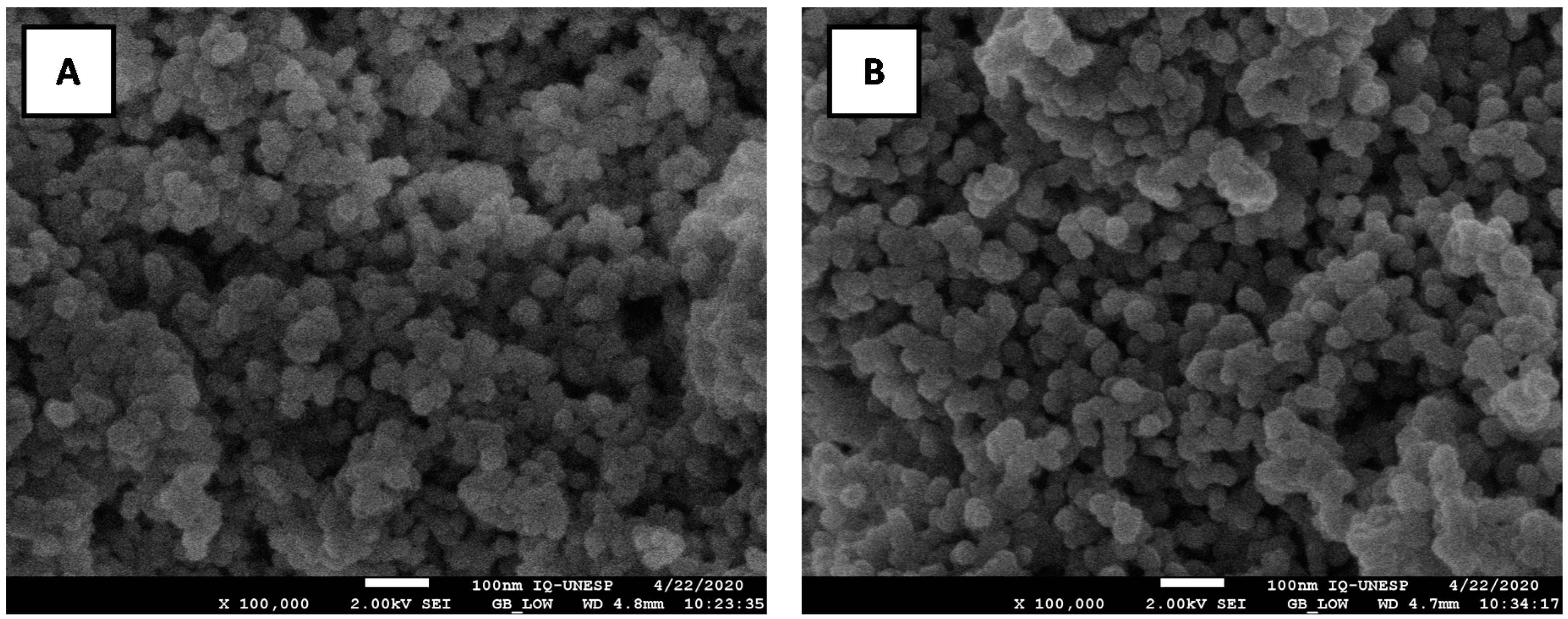
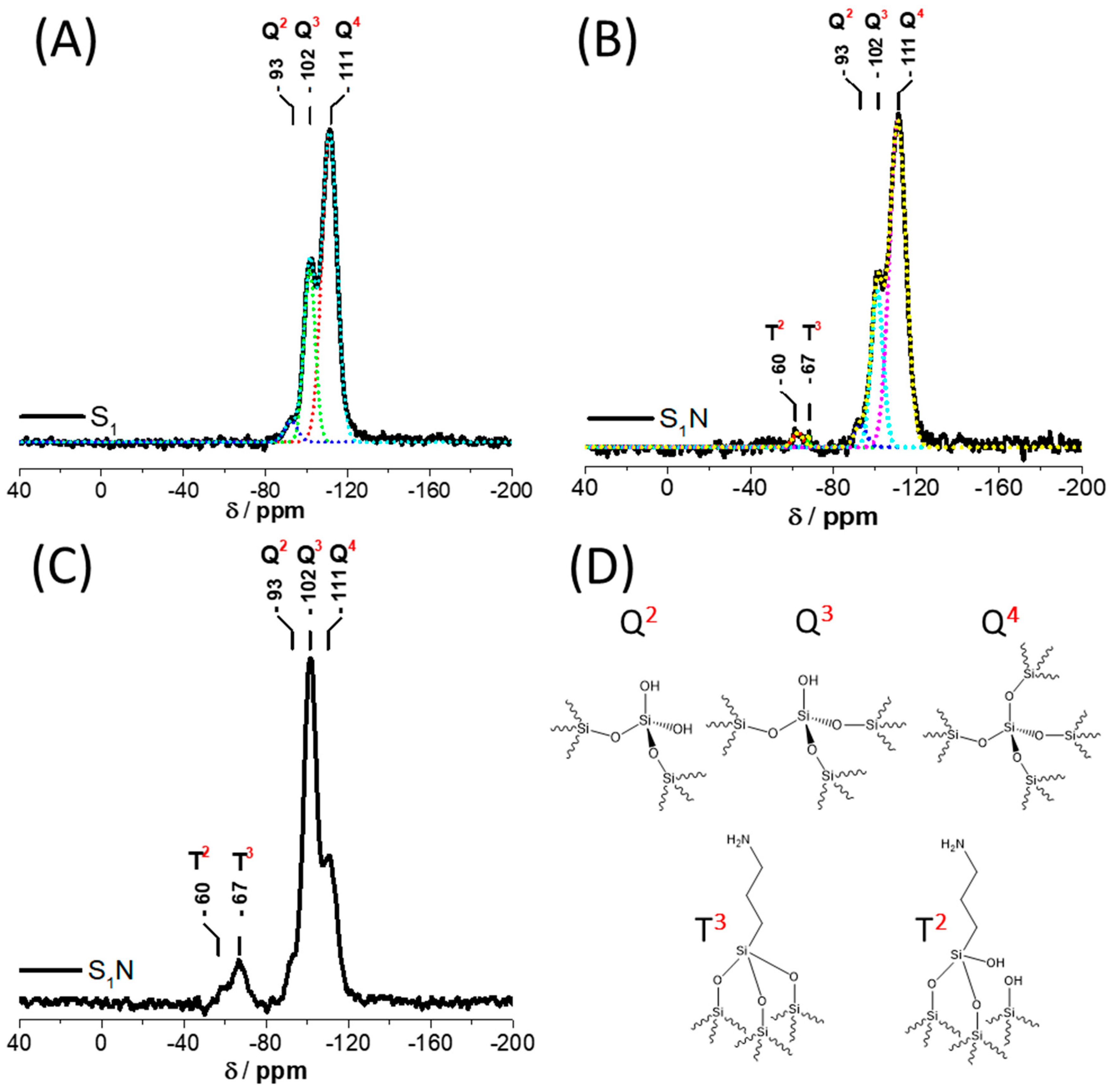


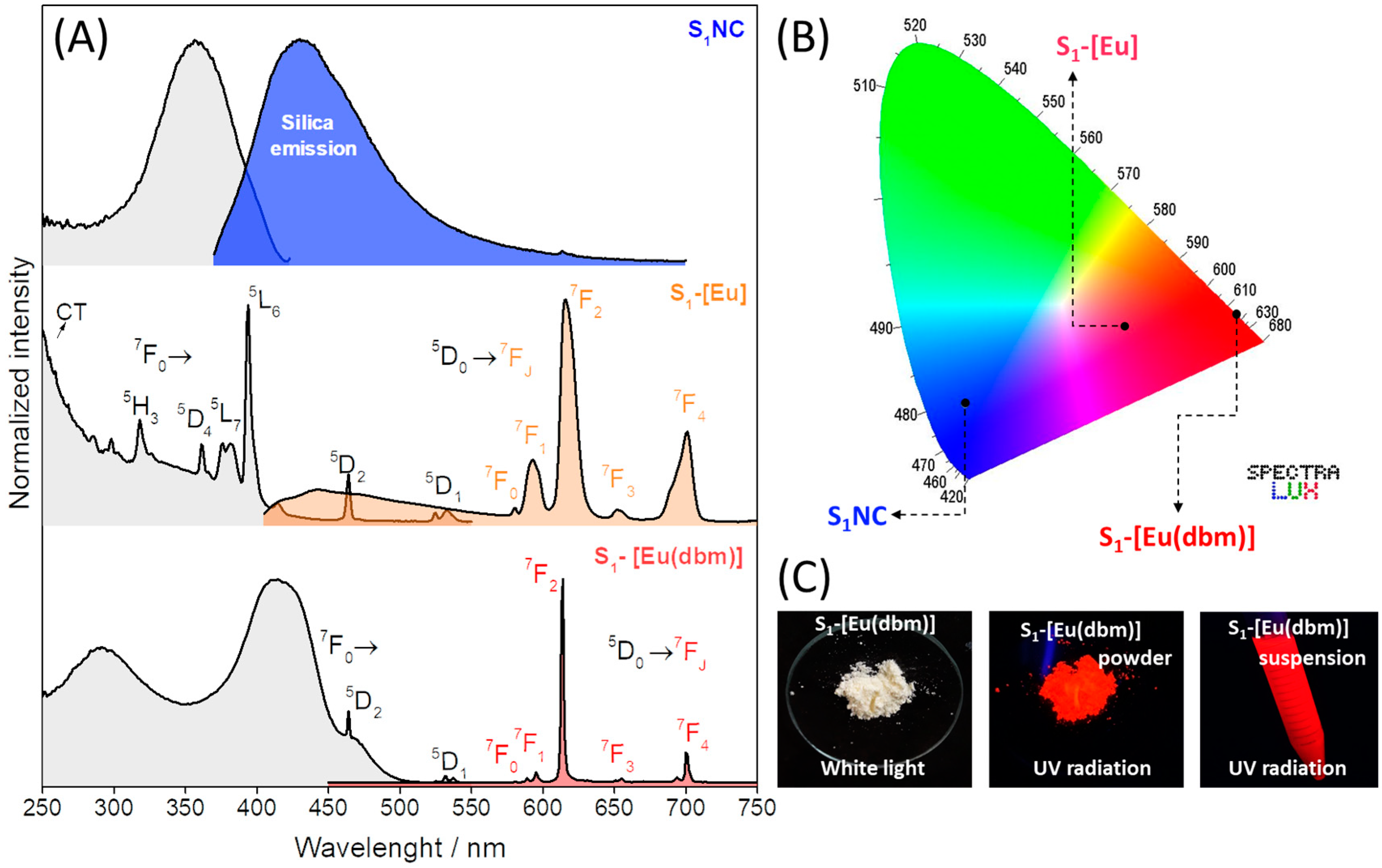
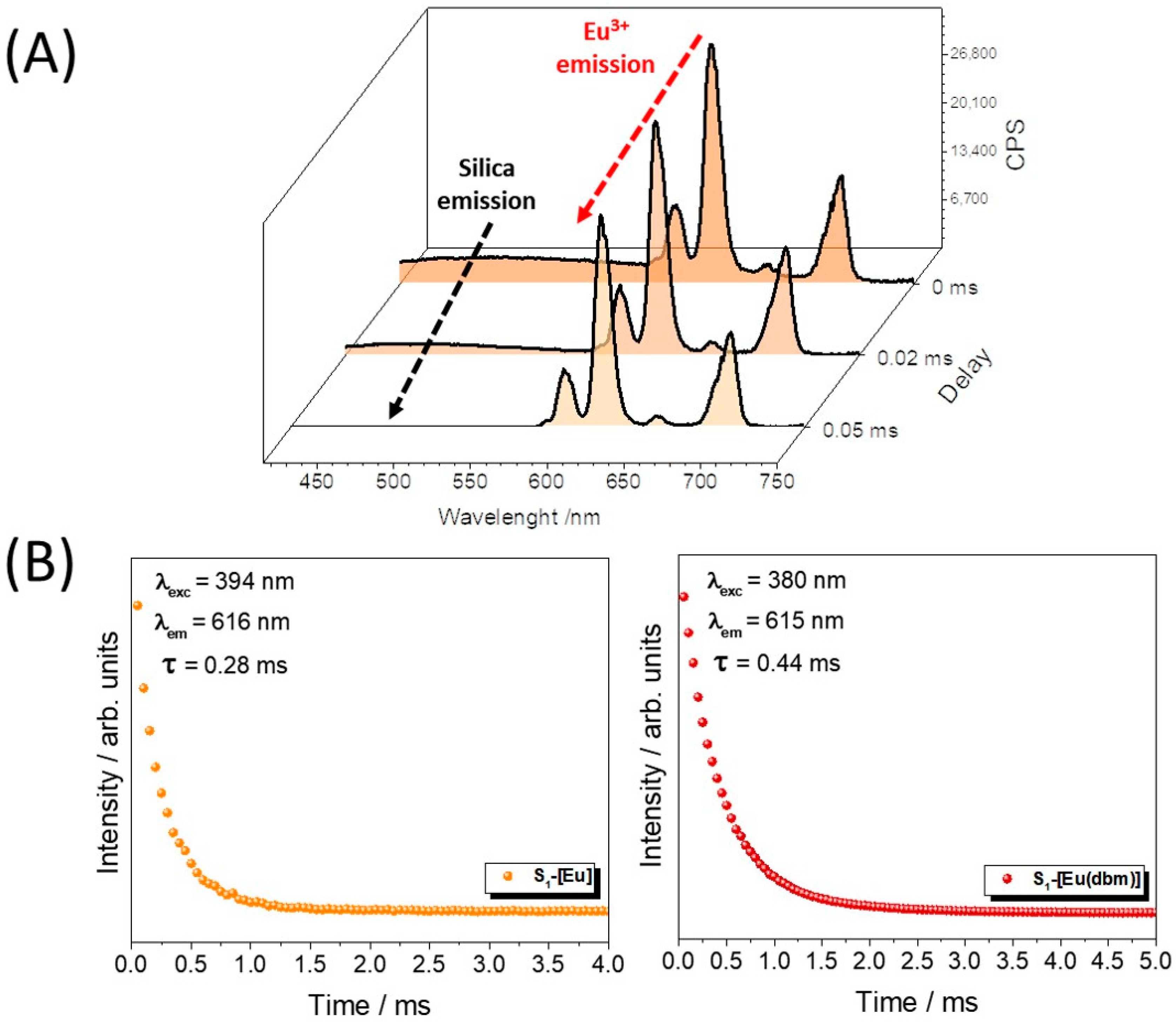

| S1 Sample | S1N Sample | |
|---|---|---|
| Groups | Group Quantity in mol% | Group Quantity in mol% |
| Q4 | 68.04 ± 0.25 | 70.27 ± 0.40 |
| Q3 | 27.99 ± 0.34 | 24.05 ± 0.63 |
| Q2 | 3.97 ± 0.24 | 3.55 ± 0.43 |
| T3 | - | 0.25 ± 0.06 |
| T2 | - | 1.87 ± 0.17 |
| Sample | τ/ms | Arad/s−1 | Anrad/s−1 | ||
|---|---|---|---|---|---|
| S1-[Eu] | 0.28 | 398 | 3225 | 11 | 3.5 |
| S1-[Eu(dbm)] | 0.44 | 864 | 1387 | 38 | 1.6 |
| System | [ref] | Ligands | Host | |
|---|---|---|---|---|
| Phen-Eu-DBM-SiO2/ZnO | [59] | dbm− and phen | ZnO/SiO2 | 55.3 |
| Eu–DBM–SiO2/ZnO | [59] | dbm− | ZnO/SiO2 | 22.6 |
| Sil2N-EDTAEu-dbm | [60] | EDTA modified and dbm− | Silica Gel (commercial) | 52.3 |
| SiO2-APTES-cpa-Eu(DBM)3 | [61] | dbm− | Mesoporous silica | 41.1 |
| Sample C | [62] | dbm− | ORMOSILs | 39.2 |
| Eu(DBMSi-SBA-15)3phen | [63] | dbm− and phen | Mesoporous silica | 32.7 |
| bpy-Eu-DBM-S16 | [64] | dbm− and 2,2′-bipyridine | Mesoporous silica | 7.7 |
| SiO2-[Eu(SB)(dbm)y] | [12] | Schiff base and dbm− | Dense silica | 32.0 |
| Eu(DBM-SBA-15)3PMAA | [65] | dbm− and PMAA2 polymer | Mesoporous silica | 10.5 |
| SiO2@Eu-DBM | [66] | dbm− | Mesoporous silica | 14.0 |
| Eu(ZnO-MAA-PHEMA-SBA-15)(DBM)3 | [67] | dbm− and silylated polymer | Mesoporous silica | 22.3 |
| Fe3O4|SiO2|1NEu | [68] | EDTA modified and dbm− | Fe3O4@SiO2 | 36.0 |
| Eu(Dbm-Si)3 Phen/SiO2 | [69] | dbm− and phen | Silica | 9.0 |
| S1-[Eu(dbm)] | This study | dbm− and carboxylic acid | Dense silica | 38.4 |
Publisher’s Note: MDPI stays neutral with regard to jurisdictional claims in published maps and institutional affiliations. |
© 2020 by the authors. Licensee MDPI, Basel, Switzerland. This article is an open access article distributed under the terms and conditions of the Creative Commons Attribution (CC BY) license (http://creativecommons.org/licenses/by/4.0/).
Share and Cite
Santos, J.A.O.; Mutti, A.M.G.; Bispo-Jr, A.G.; Pires, A.M.; Lima, S.A.M. Red-Emitting Hybrid Based on Eu3+-dbm Complex Anchored on Silica Nanoparticles Surface by Carboxylic Acid for Biomarker Application. Materials 2020, 13, 5494. https://doi.org/10.3390/ma13235494
Santos JAO, Mutti AMG, Bispo-Jr AG, Pires AM, Lima SAM. Red-Emitting Hybrid Based on Eu3+-dbm Complex Anchored on Silica Nanoparticles Surface by Carboxylic Acid for Biomarker Application. Materials. 2020; 13(23):5494. https://doi.org/10.3390/ma13235494
Chicago/Turabian StyleSantos, João A. O., Alessandra M. G. Mutti, Airton G. Bispo-Jr, Ana M. Pires, and Sergio A. M. Lima. 2020. "Red-Emitting Hybrid Based on Eu3+-dbm Complex Anchored on Silica Nanoparticles Surface by Carboxylic Acid for Biomarker Application" Materials 13, no. 23: 5494. https://doi.org/10.3390/ma13235494
APA StyleSantos, J. A. O., Mutti, A. M. G., Bispo-Jr, A. G., Pires, A. M., & Lima, S. A. M. (2020). Red-Emitting Hybrid Based on Eu3+-dbm Complex Anchored on Silica Nanoparticles Surface by Carboxylic Acid for Biomarker Application. Materials, 13(23), 5494. https://doi.org/10.3390/ma13235494







